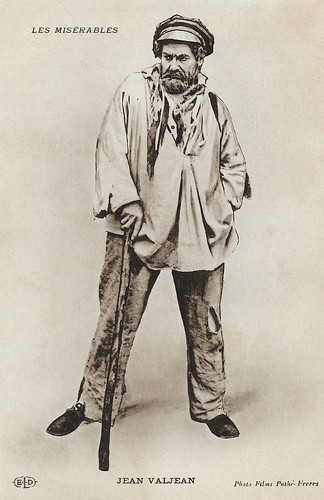
French postcard by ELD. Photo: Films Pathé-Frères. Henry Krauss in Les Misérables (Albert Capellani, 1913). Sent by mail in 1916.
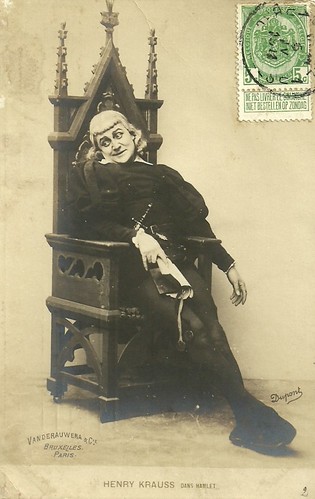
Belgian / French postcard by Vanderauwera & Coe., Bruxelles / Paris. Photo: Dupont. Henry Krauss in 'Hamlet' by William Shakespeare.

Belgian / French postcard by Vanderauwera & Coe., Bruxelles / Paris. Photo: Dupont. Henry Krauss in the lead role of the stage play 'Paillasse' by Adolphe d'Ennery.
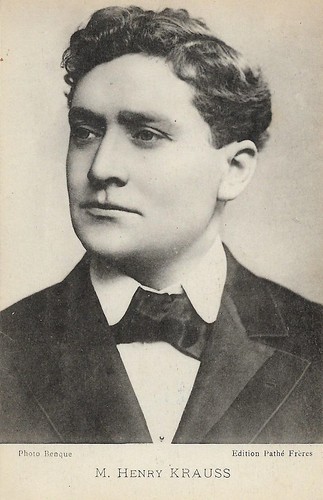
French postcard by Edition Pathé Frères. Photo: Benque.

French postcard in the Les Vedettes de l'Ecran Series by Editions Filma, no. 51. Photo: Pathé Consortium Cinéma.
The Hunchback of Notre-Dame
Henry Krauss, sometimes credited as Henri Krauss, was born as Henry Kraus in Paris in 1866. For two decades he appeared on the stages of Paris in plays like 'Valet de cœur' (1893), 'La peur des coups' (1894) and 'Théroigne de Méricourt' (1902).
In 1908 he discovered the early cinema and played parts in short silent films as L'Arlésienne (Albert Capellani, 1908), based on the play by Alphonse Daudet, and Marie Stuart/Mary Stuart (Albert Capellani, 1908). In the next five years, he played a wealth of powerful leading roles for SCAGL (Société Cinématographique des Auteurs et Gens de Lettres) and Krauss became one of the film studio’s first character stars.
Krauss played Buridau in the film adaptation of Alexandre Dumas' La tour de Nesle/The Tower of Nesle (Albert Capellani, 1909), the title character in the drama Le lépreux de la cité d'Aosta/The leper of the city of Aosta (André Calmettes, 1910), the bohemian in L’oiseau s’envole/The bird flies (Albert Capellani, 1911), Dr. Cezambre in the crime melodrama La glu/The Siren (Albert Capellani, 1913) featuring Mistinguett, and Prince Grégoire III in Le réveil/The alarm (1914).
Before the First World War, he became a star with his interpretations of two characters from novels by Victor Hugo. In 1911 he starred as Quasimodo in Notre Dame de Paris/The Hunchback of Notre-Dame (Albert Capellani, 1911) opposite Stacia Napierkowska as Esmeralda, and in Les Misérables (Albert Capellani, 1913), he was Jean Valjean, relentlessly pursued by the Justice.
His last starring role before the war was Étienne Lantier in Émile Zola's Germinal (Albert Capellani, 1913) with Sylvie.
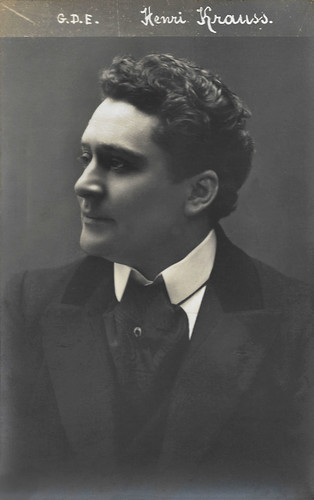
Belgian postcard. Photo by G.D.E. (G. Dupont-Emera, Brussels).

Belgian postcard. Photo by G.D.E. (G. Dupont-Emera, Brussels).
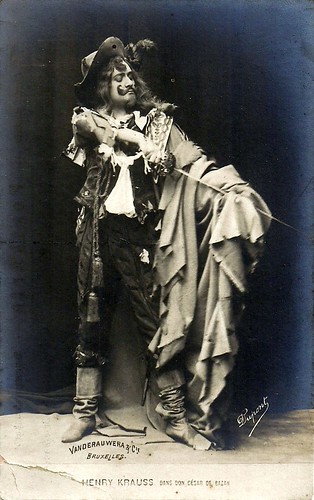
Belgian postcard by VanderAuwera & Cie., Bruxelles. Photo: Dupont. Caption: Henry Krauss in 'Don César de Bazan'. 'Don César de Bazan' is an opéra comique by Jules Massenet, based on the drama 'Ruy Blas' by Victor Hugo.

Belgian postcard by VanderAuwera & Cie., Bruxelles. Photo: Dupont. Caption: Henry Krauss in 'Don César de Bazan'. 'Don César de Bazan' is an opéra comique by Jules Massenet, based on the drama 'Ruy Blas' by Victor Hugo.
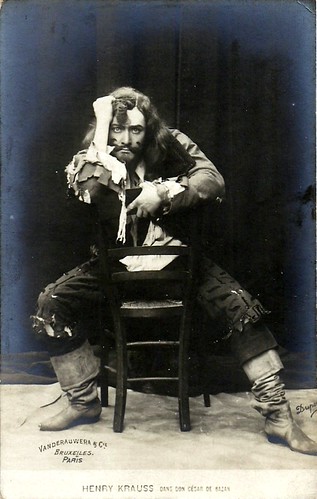
Belgian postcard by VanderAuwera & Cie., Bruxelles. Photo: Dupont. Caption: Henry Krauss in 'Don César de Bazan'. 'Don César de Bazan' is an opéra comique by Jules Massenet, based on the drama 'Ruy Blas' by Victor Hugo.

Vintage postcard. Photo: Dupont. Caption: Henry Krauss in 'Don César de Bazan'. 'Don César de Bazan' is an opéra comique by Jules Massenet, based on the drama 'Ruy Blas' by Victor Hugo.
Napoleon
Although Henry Krauss remained active in front of the camera after the war, his star rapidly declined. He was the uncle of Gina Relly in L'empereur des pauvres/The Emperor of the Poor (René LePrince, 1922), and played the lead in Le bossu/The Hunchback (?, 1923) with Claude Mérelle.
In 1925, the nearly 60-year-old artist played another signature role again as the father of the title character in Poil de carotte/Carrot Hair (Julien Duvivier, 1925). In the late 1920s and 1930s, his acting style was considered too pompous and exaggerated.
Krauss occasionally worked as a director. In 1925/1926 he was an assistant director to Abel Gance in the classic epic Napoleon. He had a supporting part in the sound film Le procureur Hallers/The Prosecutor Hallers (Robert Wiene, 1930) starring Jean-Max and Colette Darfeuil.
It was the French-language version of the German film Der Andere/The Other (Robert Wiene, 1930) based on the play Der Andere by Paul Lindau. The two films were made at the same studio in Berlin, with Wiene beginning work on the French version immediately after finishing the German film.
Over two decades after his Jean Valjean interpretation in Les Miserables (1913), Henry Krauss also appeared in the first sound film version of the Victor Hugo adaptation, Les Misérables (Raymond Bernard, 1934). This time Harry Baur interpreted Jean Valjean and Krauss had to be content with the much smaller role of Mgr. Myriel. At the age of 69, Henry Krauss died in 1935 in his hometown Paris. His son was the art director Jacques Krauss.

French postcard by E.L.D. Photo: Films Pathé Frères. Publicity still for Les Miserables (Albert Capellani, 1913), with Henry Krauss (left) as Jean Valjean, Léon Lérand as Gillesnormand, Marialise as Cosette, and Gabriel de Gravone as Marius. Caption: Les fiançailles de Marius et de Cosette (The betrothal of Marius and Cosette).

French postcard by M. Le Deley, Paris. Photo: Pathé Consortium Cinéma. Henry Krauss in L'empereur des pauvres/The Emperor of the Poor (René Leprince, 1921).

French postcard by M. Le Deley, Paris. Photo: Pathé Consortium Cinéma. Publicity still for L'empereur des pauvres/The Emperor of the Poor (René Leprince, 1921). In the middle, Gina Relly as Sylvette, and right, Henry Krauss, as her uncle Jean Sarrias, revolting against society. Left could be Andrée Pascal as Clémence Sarrias.

French postcard. Photo: Pathé. Platinogravure.

Spanish postcard by La Novela Semanal Cinematográfica, no. 142.
Sources: Wikipedia (French, German, and English) and IMDb.
This post was last updated on 24 January 2025.
No comments:
Post a Comment